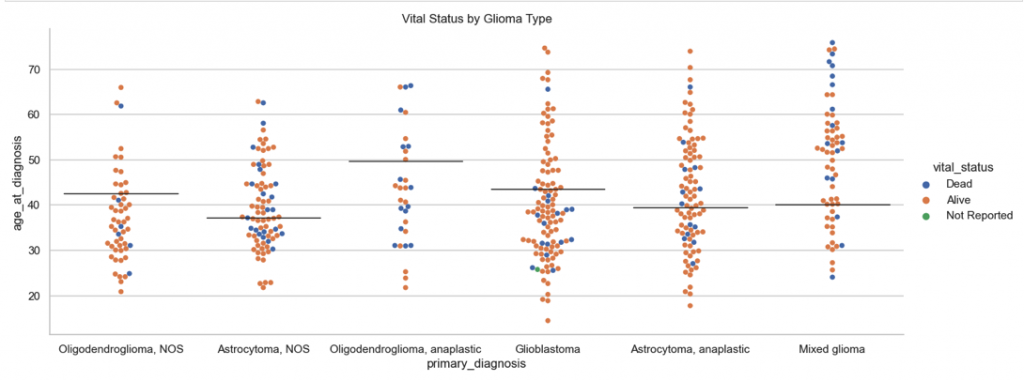I was chatting last week with an acquaintance. He asked me why I was volunteering with the Low Grade Glioma Registry. I explained about Susie’s type of brain cancer and that the clinical and genomic data available to the public and scientific community was quite limited. He was surprised to hear this. So I pulled up the NIH National Cancer Institute GDC Portal, and showed him what data was publicly available for IDH1 mutant gliomas (425 cases, 394 from TCGA-LGG, 23 from TCGA-GBM and 8 from CPTAC-3).

For obvious reasons, the genomic related files (VCF, BAM) and a few other files are under “controlled” access, which means not publicly available. There is high level gene mutation information provided if you drill down, but that data is not bulk exportable via the GDC Data Portal. The Broad Institute has created and kindly shares python tooling for working with GDC Data Portal’s API, publicly available via the gdctools repository in GitHub. I plan to pull it down and see what I can query and assemble with it.
In the meantime, I did a quick export of the above information and broke down some numbers based on age_at_diagnosis, gender, primary_diagnosis and vital_status. The analysis source code and graphs are posted in my Glioma repository. I found the following two charts relevant:


For context Susie’s initial diagnosis in 1999 was a mixed glioma. With molecular sequencing today, we do not see this classification anymore. Low grade gliomas today are typically grouped as either astrocytoma or oligodendroglioma. Also IDH1 mutant Glioblastoma used to be known as a Secondary Glioblastoma, which is what Susie’s recurrence in 2013 was classified as. According to the WHO 2021 Classification of CNS tumors, Secondary Glioblastoma is now classified as a Grade 4 Astrocytoma.
It is unclear how or when the GDC Data Portal will reflect the new CNS classification, but the exported data is rudimentary and simply too small for higher confidence analysis. Rather than waiting for government agencies, tertiary cancer hospitals and others to work through how they want to organize and share data, I feel the Low Grade Glioma Registry gives patients the opportunity to make an independent decision that hopefully can make such data available quicker to researchers who want to work on low grade gliomas.
For more information on Low Grade Gliomas and the Registry, check out the following:
- ABTA Low Grade Glioma Patient and Family Meeting Recordings
- The International Low Grade Glioma Registry
PS: I find the term “low grade glioma” problematic, as it seems to convey these are not aggressive brain tumors. Yet some are very aggressive when initially diagnosed or when they recur. Some may recur and while the grading may not change, they keep recurring. The adverse events due to treatment and location of these tumors are certainly not benign.
Its like you read my mind! You appear to know so much about this, like you wrote the book in it or something. I think that you can do with a few pics to drive the message home a little bit, but other than that, this is fantastic blog. A great read. I’ll certainly be back.
Pingback: Using National Cancer Institute GDC API – Back From Across The Pond